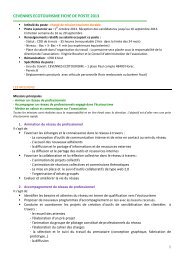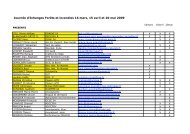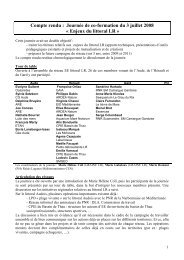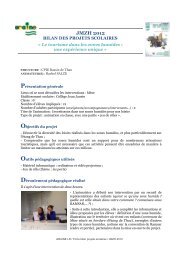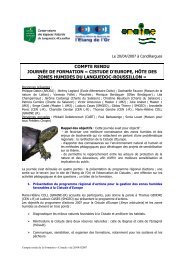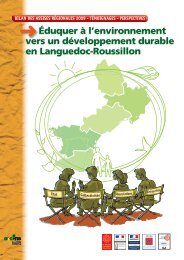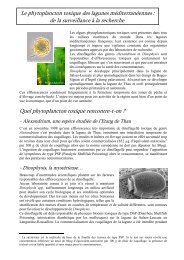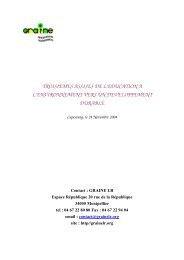Guide de la Diren LR - Le GRAINE LR
Guide de la Diren LR - Le GRAINE LR
Guide de la Diren LR - Le GRAINE LR
You also want an ePaper? Increase the reach of your titles
YUMPU automatically turns print PDFs into web optimized ePapers that Google loves.
BirdLife International (2004)<br />
Non SPEC.<br />
Statut<br />
national<br />
SEOF-LPO (1999) Vulnérable – CMAP 5<br />
Statut<br />
régional<br />
Meridionalis (2004)<br />
Vulnérable<br />
Divers<br />
Espèce nicheuse récente pour <strong>la</strong> France<br />
MENACES IDENTIFIEES<br />
Assèchement naturel ou artificiel <strong>de</strong>s marais pendant <strong>la</strong> pério<strong>de</strong> <strong>de</strong> reproduction (diminution <strong>de</strong>s<br />
disponibilités alimentaires et augmentation <strong>de</strong>s risques <strong>de</strong> prédation).<br />
Menace sur<br />
l’espèce<br />
Pâturage intensif : risques <strong>de</strong> <strong>de</strong>struction <strong>de</strong>s nichées (piétinement, visibilité du nid)<br />
Pollution <strong>de</strong>s eaux (diminution <strong>de</strong>s disponibilités alimentaires)<br />
Inondation <strong>de</strong>s nichées par augmentation <strong>de</strong>s niveaux d’eau rapi<strong>de</strong> au printemps<br />
Dérangement humain<br />
Destruction <strong>de</strong>s roselières (drainage pour le développement agricole et urbain ou surexploitation <strong>de</strong> <strong>la</strong><br />
sagne).<br />
Salinisation <strong>de</strong>s p<strong>la</strong>ns d’eau (régression <strong>de</strong> <strong>la</strong> roselière au profit <strong>de</strong> l’eau libre).<br />
Menace sur<br />
ses habitats<br />
Atterrissement <strong>de</strong> <strong>la</strong> roselière (évolution <strong>de</strong> <strong>la</strong> roselière vers un milieu terrestre buissonnant suite à<br />
l’accumu<strong>la</strong>tion <strong>de</strong> matière végétale).<br />
Aménagements cynégétiques : création <strong>de</strong> grands c<strong>la</strong>irs et régime hydrologique favorisant l’assèchement<br />
printanier plutôt qu’estival.<br />
Pâturage intensif : hauteur et <strong>de</strong>nsité <strong>de</strong> roseaux insuffisantes.<br />
Diminution du nombre <strong>de</strong> sites <strong>de</strong> nidification en arbres.<br />
MESURES DE CONSERVATION ENVISAGEES<br />
Maintien <strong>de</strong> vastes surfaces <strong>de</strong> roselières<br />
Gestion <strong>de</strong>s boisements occupés pour <strong>la</strong> reproduction ou potentiellement utilisables<br />
Garantir un maximum <strong>de</strong> tranquillité lors <strong>de</strong> <strong>la</strong> reproduction et éviter les intrusions humaines<br />
CODE<br />
ACTION<br />
G10<br />
G12<br />
G23<br />
BIBLIOGRAPHIE<br />
CRAMP S. & SIMMONS K.E.L (1977). The Birds of the Western Palearctic. Vol. I. Oxford University Press, Oxford, London, New-<br />
York.<br />
KAYSER Y., COHEZ D. & MASSEZ G. (2006). Gran<strong>de</strong> Aigrette Ar<strong>de</strong>a alba. In LASCEVE M., CROCQ C., KABOUCHE B., FLITTI A. &<br />
DHERMAIN F., Oiseaux remarquables <strong>de</strong> Provence. Ecologie, statut et conservation. De<strong>la</strong>chaux et Niestlé, Paris.<br />
KAYSER Y., PINEAU O. & HAFNER H. (1992). Evolution <strong>de</strong>s effectifs <strong>de</strong> quelques oiseaux peu communs hivernant en Camargue.<br />
Faune <strong>de</strong> Provence 13 : 25-26.<br />
KAYSER Y., PINEAU O., HAFNER H. & WALMSLEY J. (1994). La nidification <strong>de</strong> <strong>la</strong> Gran<strong>de</strong> aigrette (Egretta alba) en Camargue.<br />
Ornithos 2 : 81-82.<br />
LE MARECHAL P. & MARION L. (1999). Gran<strong>de</strong> Aigrette Egretta alba. In ROCAMORA G. & YEATMAN-BERTHELOT D., Oiseaux<br />
menacés et à surveiller en France. SEOF, LPO, Paris.<br />
VOISIN C. (1991). The herons of Europe. T & AD Poyser, London.<br />
Catalogue régional <strong>de</strong>s mesures <strong>de</strong> gestion <strong>de</strong>s habitats et <strong>de</strong>s espèces d’intérêt communautaire – Type <strong>la</strong>gunes littorales. DIREN <strong>LR</strong>.<br />
BIOTOPE, CEN-<strong>LR</strong>, Tour du Va<strong>la</strong>t, Pôle Re<strong>la</strong>is Lagunes méditerranéennes. 2007.<br />
95


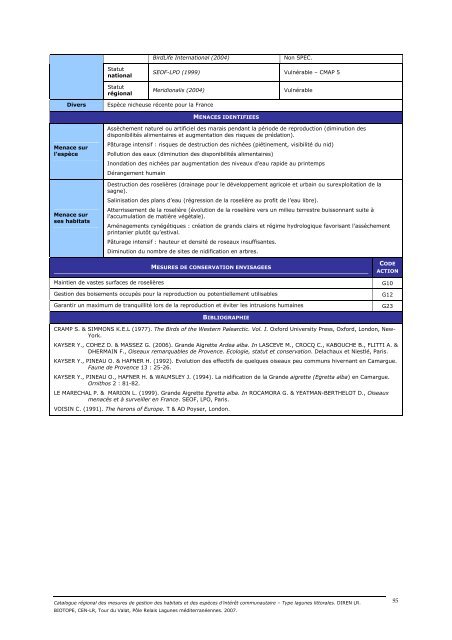
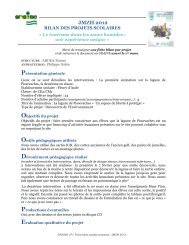
![[PDF] : grainelr.org - Le GRAINE LR](https://img.yumpu.com/43844933/1/184x260/pdf-grainelrorg-le-graine-lr.jpg?quality=85)
